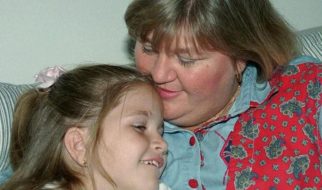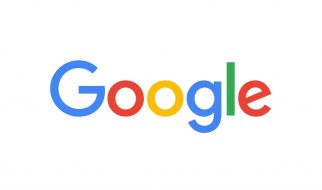You may have never heard of Debra Granik?s film, but its story has pertinent significance and highlights the institutional problem that led to Green Book?s 2019 Best Picture win. Karim Noorani dissects what he thinks is one of the best films of last year
 (Amazon Prime / Photo Illustration by Ben Fenichel)
(Amazon Prime / Photo Illustration by Ben Fenichel)
Editor?s Note: The writing below contains some spoilers from the film Leave No Trace. If you wouldn?t like to have any of the plot details spoiled, we suggest reading this after watching the film.
I?ve watched Debra Granik?s Leave No Trace three times by now, and the sharpness of the film still amazes me. Granik does not muddy her story with unwonted settings, extraneous characters, or plot gimmicks. She prizes much more the minutiae of filmmaking ? shot placement, color vibrance, and cinematic simplicity. It?s moviemaking like this that compels the audience to marvel at the incidental details of life: emphasizing who we are with, where we are, how we feel, and what we overlook. That is Leave No Trace?s cinematic awakening.
The film?s veracity means that Granik does not need to utilize guns or extraordinary violence to raise plot stakes. The character development of Leave No Trace?s two protagonists, Will and Tom, does that for her. The movie also never feels the need to put any ?I feel?? moments into its dialogue. Depicting a harsh, unadulterated environment leaves the characters? emotions implicitly obvious. Lastly, Granik does not need to devise a profound, embellished takeaway at the end of Leave No Trace. Not shying away from issues such as veterans PTSD, societal conformism, and harmful parenting ? coupled with faithful storytelling ? delivers a much more natural and commendable conclusion.
The American filmmaker?s style has drawn high acclaim from many in the industry. Leave No Trace is the second-most reviewed film to ever hold a perfect approval rating on Rotten Tomatoes. Granik?s previous film, Winter?s Bone, was nominated for four Oscars in 2011, including Best Picture; it?s also widely known for launching actress Jennifer Lawrence into stardom.
A large part of that praise comes from Granik?s unwavering moviemaking philosophy: empathy. ?I always think that my assignment is to seek out stories that are experienced by people who don?t get the ticket for Easy Street,? Granik said in an interview with Tomris Laffly. ?One of my jobs as a storyteller, in the way that I self-describe my job, is to engender some kind of consideration or empathy; to ask some questions that at least make you motivated to want to understand another person.?
However, the Oscar-nominated director has also gone on record saying her style conflicts with mainstream Hollywood. Granik?s narrative interests have not ordinarily coincided with highly financed studios; this is one of the reasons Leave No Trace was made by Bleecker Street ? a film company founded a mere five years ago ? rather than a Warner Bros. or Universal. Simply put, no big-budget studio wanted to broach Leave No Trace?s sensitive topics. Not only might the film have been unmarketable in their eyes, but it also had the chance to spark an uneasy conversation at a time of political upheaval.
The fact that a director could be simultaneously blackballed and lauded for her style shows the fine line between pertinent storytelling and industrial taboo that filmmakers often have to walk. Granik?s battle isn?t about money, fame, or recognition ? she?s fighting for creative freedom. The director wants to use her film as a podium to air overlooked injustices, yet unlike other artists, she needs a team and immense financing to carry out her vision. For better or worse, the movie industry simply does not allow a filmmaker to be a modern-day Picasso: reclusive-yet-ingenious.
Fortunately, Leave No Trace eventually found a compatible studio, and its impact may forever change the way viewers perceive veterans? mental health. But as profound and detail-oriented a filmmaker as Granik is, what questions did she embed deeper within her film? Why did the film conclude the way that it did? What is the film telling us about its stigmatized topics? Why did Leave No Trace go on to simultaneously become one of the most critically-acclaimed and overlooked movies of our time?
Without further ado, let?s dissect Leave No Trace.
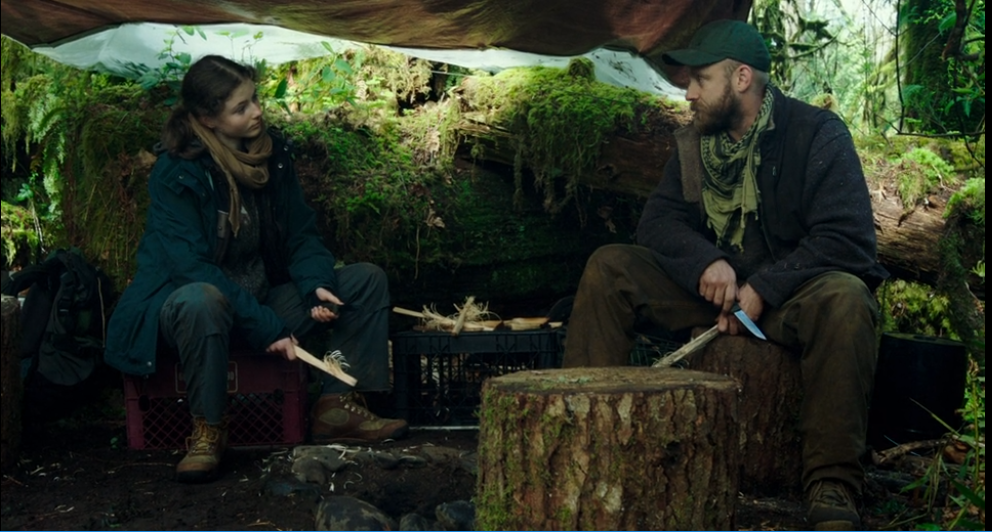 (Amazon Prime)
(Amazon Prime)
This is one of the film?s initial scenes, in which Tom (left) and Will (right) are feathering wood to make a fire. At first glance, the shot seems to be nothing noteworthy; it?s two characters simply stopping to glance at one another. And yet, the framing ? among other elements ? highlights an important concept within the film: equality.
This moment in the film utilizes a two-shot, which is a shot characterized by two characters occupying the same, intimate frame in equal measure. You might see this traditionally in romantic films (think: side view of guy-meets-girl), but Leave No Trace makes use of such framing a lot in Will and Tom?s father-and-daughter relationship. The shot is not so much tied to romanticism as it is to equity and intimacy, the film showcasing two closely-related characters as equals.
Two other elements to point out are the hierarchy of scale and symmetry, a couple of very different visual tools that add up to the same effect. Note how neither Tom nor Will seems to be towering over the other in the shot, which is a deliberate effort that can be noted throughout the film. Ben Foster, the actor who plays Will, is comfortably taller than Thomasin McKenzie, the actress who plays Tom. Yet Granik chooses to sit them at roughly eye level and a symmetrical part of the frame away of each other. Although Will is still an overprotective father to Tom in the film, this egalitarian approach to filming the movie?s main characters wisps away the thought of their situation being uncomfortable.
To prove this point, there are many moments in the film where Tom could have expressed alarming tensions about her father if she so felt. After the father and daughter are apprehended for illegally residing in a forest, Tom is brought into a child protective services room with other girls her age, and she?s probed about her lifestyle.
When pressed about being homeless, McKenzie?s character responds ?they just don?t understand that [the forest] was my home.? Regardless of her living situation (where she lacked stable food, shelter, and other necessities), Tom still defended her home in the forest, which was pervaded by a single constant ? her father. Though aware of societal norms, she never felt ashamed or uncomfortable of the way Will made them live.
This scene also represents the movie?s first explicit confrontation of societal conformism. Should Will and Tom really be classified as homeless if living in the forest was a choice? At what point are our social schema marginalizing the ?other? and how should the audience handle that? These are questions Granik plants very early on in the film.
In another scene, a social worker asks Tom if she was uncomfortable sharing a tent with her father, to which McKenzie?s character replies ?No, it?s warmer with two people at night.? The affection between the father and daughter becomes evident in moments like this. Will also displays one of his rare smiles in the film when he is asked about his daughter by a social worker. As we learn later on in the film, Will and Tom?s relationship can not always be characterized as healthy, but it?s the film?s even-handed approach to cinematizing Will and Tom that foretells and, at times, reminds viewers that the plot?s central relationship is in no way ominous.
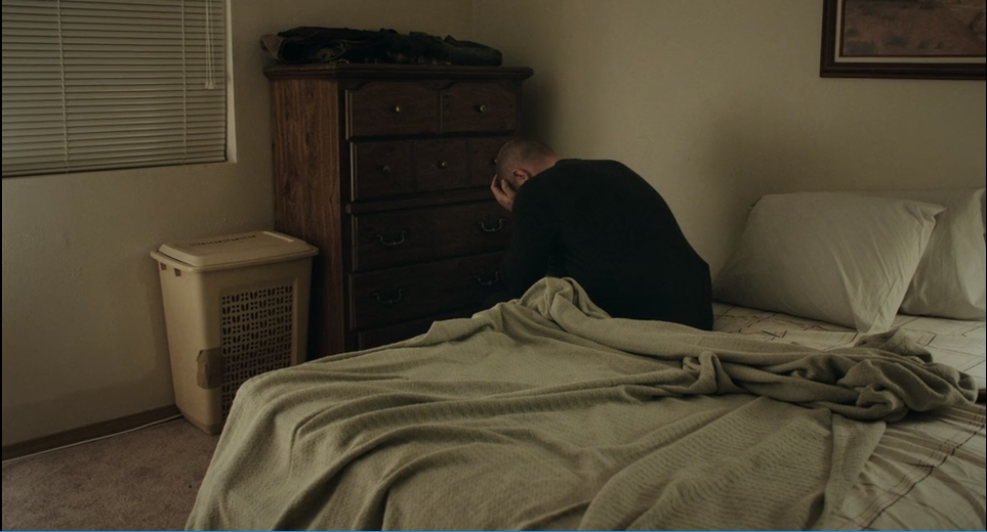 (Amazon Prime)
(Amazon Prime)
This is a shot of Will shortly after he and Tom are relocated to permanent housing. Foster, in this position with his hands cradling his head, is an emblematic image in the film and symbolizes the pain his character is feeling but cannot express. Viewers learn early on in the movie that Will recurringly sells his PTSD medication to pay for small necessities that he and Tom need in the forest. Now, while integrating into a community, Will starts to experience the worsening effects of his mental health.
Though the quality is much better, the shot is almost Godfather-esque ? subdued and airless. The lighting seems to be done with lamps, bulbs and other common sources. Granik was very careful to not include any bright objects and place Foster?s character more than arm?s length away from the camera, gravitating towards the room?s shade. The picture is illustrating the alienating and sometimes desolating effects of PTSD, particularly towards veterans.
Right before this scene, when father and daughter first arrive in the house, there?s a quote that illuminates the central conflict within Will. Foster?s character tells Tom ?we can still think our own thoughts? when asked about the drastic changes they?re experiencing, and McKenzie?s character later repeats the saying to Will, when he expresses concern about her integrating too much.
It?s such an eerie and tension-filled scene between the father and daughter, who are standing on opposites ends of the screen. The camera flicks back and forth between the two characters? close-ups, and every light appears to be on. The film is showcasing exposure in their relationship, and that?s when Tom stings Will with her phrase ? and vice versa.
But what Tom doesn?t realize about her father is that he very quickly recognized in their transition that he couldn?t think his own thoughts, and the restless nature within him that became entrapped and paranoid by the structure of a community. Foster?s character ultimately adopts an us-versus them-mentality, which culminates in Will and Tom fleeing to live in the woods in Washington.
Leave No Trace?s next sequence is very somber. The realization that Will?s nature may be harming his daughter slowly creeps into the audience. Foster and McKenzie?s characters face numerous problems such as weather, heat, and shelter. Will and Tom almost freeze to death before finding a cabin to warm themselves. Foster?s character goes on a trip to find food while Tom incidentally learns of her father?s mental health issues through stray documents. At this point, the film also alludes to Will once being in a military unit that has now been ravaged by a string of suicides.
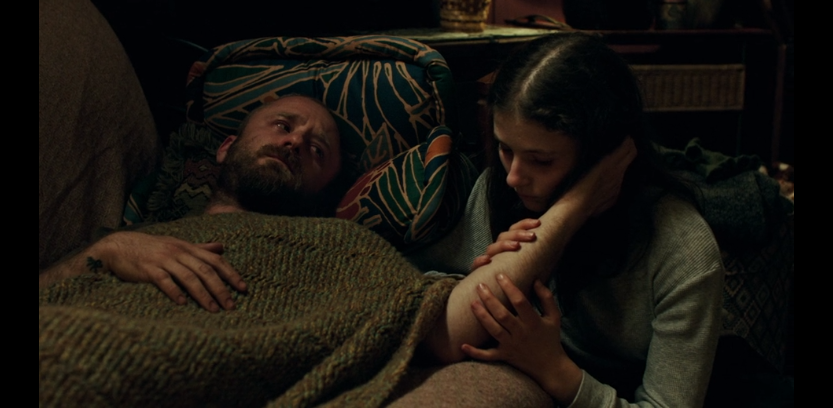 Amazon Prime
Amazon Prime
This is a shot of Will after Tom finds him lying unconscious in the woods and brings him to a good Samaritan?s house. At this moment, Will whispers ?I?m so sorry? to Tom, who replies ?I know.? It?s a touching moment for the movie?s two protagonists, whose relationship was otherwise growing strained and distrustful.
Will is portrayed in a helpless position in this picture. The orientation of his body and vigor in his face both imply that this might be a death scene. The space of the frame seems to close in on him and make the shot much tighter ? even claustrophobic. However, the portrayal is more foreboding in the metaphorical sense than literal. Will is starting to acknowledge his own makeup and the effects it has on his daughter. He is unable to deal with confinement and constancy because of his PTSD, which in turn is harming Tom?s capability to live a stable life.
As Will recovers, the father and daughter begin to ingratiate into a new community, one that does not marginalize or ostracize them because of their past. Housing former war veterans, the small trailer-park neighborhood understands Will and the mental health issues he experiences. He is given a therapy dog, Boris, to calm his restlessness. Tom finally gets the authentic interactions she craved earlier in the film and tries to get her father to enjoy them as she does.
Eventually, though, his leg isn?t fully healed, Will tells Tom that they need to leave the community, and Tom?s feelings come to a climax when she tells her father ?the same thing that is wrong with you isn?t wrong with me.? Tom still goes along with packing her things and pretending to go with him before finally garnering up the courage to tell her father she wouldn?t leave. For someone who had experienced so many traumatic events in his life that he couldn?t talk about, Will sharing his final on-film moment with his daughter was a crushing blow to him.
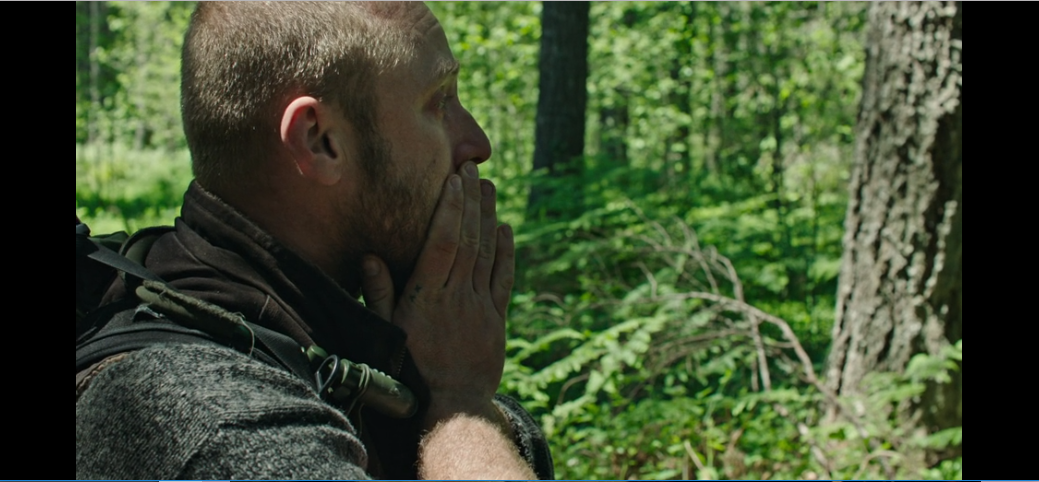 (Amazon Prime)
(Amazon Prime)
This is a shot immediately after Tom walks away from Will. Tom had given her father one final embrace and said to him ?I know you would stay if you could.? Tom?s quote is very insightful about her and the film?s perspective. Here, Leave No Trace accounts for just exactly the severity of mental illness veterans suffer from. Foster?s character simply couldn?t put a band-aid on his psychological scars, even if it meant having to leave his daughter.
The important aspect to note in the picture is positioning: Foster is halfway turned from the camera. It implies a unique set of psychological undertones. Granik wants the viewer to know that Will is partially rejecting their presence. We, as the audience, want to analyze Will?s facial expressions in this climactic scene but are unable to. It implies that Foster?s character is alienating himself from the world and coming off as an enigma.
As a plot point, Will is just that ? an enigma. No one fully understands him in the film. His backstory, marriage, and time in the military are all unknowns. The film never talks about them, yet through its cinematography, we know that it?s all slowly eating him up on the inside. Perhaps that?s just an indelible mark for veterans and inescapable reality for our current society.
The hardest anyone tries to crack the code is Tom, and in the end, she leaves it up to trust. The film ends with Mckenzie?s character hanging a bag of food in the forest ? much like Dale, the benefactor who helps Will, does for another person earlier. Tom couldn?t go through any more of the pain that came with trying to keep up with her father, but she could still hold out a lifeline, trusting her father?s indefinite trace would lead him back to her.
When it comes to the Oscars? Best Picture award, the conversation has to revolve around what world the voters want to project. Despite all of its faults, this year?s winner Green Book was a feel-good story. All of its core issues related to the Deep South, racial identity, and cultural statelessness were pushed to side at the end for a rowdy, jovial Christmas party.
Peter Farrelly?s comedy-drama film was the happy ending the Academy so desperately craved in their big show. Given all the controversies that surrounded the Oscars this year, it makes sense why the voters would want to wrap a bow upon their 2019 embarrassment. At least a portion of the committee didn?t want to thrust Bradley Cooper?s highly emotional drama about fame and depression nor Alfonso Cuarn?s Spanish film concerning suppressed identities as their movie of the year.
There are numerous things wrong the Academy?s logic but just one realization we should be coming to: we are still a stigmatized society. Leave No Trace being snubbed on a nomination should have been our first indication, but the actual Best Picture winner made it an inescapable truth. Where Moonlight brought us two steps forward, Green Book is bringing us one step back.
Separating the external strife from the film, I found nothing wrong with Farrelly?s fun-loving movie. It was an entertaining, funny, and thought-provoking film to watch for two hours. However, Green Book winning the final award brings us back to the underlying biases Granik encountered when filming touchy social topics.
No one truly understands the issues facing marginalized populations in our society. This is why those issues are continuously pushed to the side ? even on the biggest of the stages. The wisdom that we, as people, lack will only come with greater exposure. This why Granik?s trailblazing film is so important. It gave us a glimpse of human experience not often thought of in our day-to-day lives or political conversations.
Perhaps Leave No Trace is not the problem in Hollywood but a step toward the solution to an institutional problem, which has roots stemming long before this year?s awards show.
Karim Noorani is an editor at UNPLUGG?D , our resident movie expert, and the host of ?The Unplugg?d NBA Show.? You can follow him on Twitter here.

